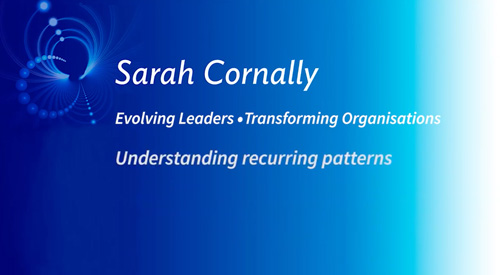
Understanding recurring patterns
Recurring patterns occur across organisations of all shapes and sizes every day. When the pattern is not healthy, and the outcomes are negatively impacting people and the business, they can be halted by understanding the systemic principles that are at play.

Recurring patterns are when it feels like groundhog day, even when circumstances and decisions are different. Despite your best attempts, the same things keep playing out, to the detriment of the organisation and those in it.
Repeated failing
A good example of this is a case in which a CEO had difficulty retaining their Chief Risk Officer. The recurring pattern was that each person who joined the company in that role, who had been carefully selected against criteria and looked like a really good fit, would soon leave following an unresolvable conflict. The person would start well enough, but each time they would hit a speed bump, and then it would spiral downwards, until ultimately the conflict between the CEO and the CRO would result with the CRO exiting the business. Naturally this had a significant operational and financial impact, including substantial exit payouts. Everybody then regrouped afterwards to consider what had worked and what hadn’t. There was deep thought given as to best practice around selection criteria and recruitment to engage somebody new who would be very different to the previous incumbents. Yet despite all this, the same pattern kept repeating itself, three times over a number of years.
What was going on? Multiple systemic dynamics were at play. On the surface, everything correct had been done. Yet when you look into it systemically, and examine what had happened with the first CRO, it revealed the CRO was given an inflated importance. Over time this created a sense of entitlement, being above others in the system. This is a form of being out of order. When the CEO sought to bring things into order the CRO had a strong reaction which provoked a battle of power. It ended with the CRO making a choice to leave the company but then making accusations that was dealt with by providing substantial compensation. This is where things went awry for the system, because this was out of exchange. It did not represent accurate give and take. This is a breach of the systemic principles of healthy exchange and right order. The next 2 x CRO repeated the same pattern which compounded the breach of systemic principles each time. It became clear that this role is carrying more responsibility than what actually should be attributed to that role. What happens if you demand too much of a role? At some point, it’s going to break down, and the person has to leave because the burden’s too heavy. Another way of describing this is ‘a burdened role’.
It becomes complicated when a burdened role is left and followed by a substantial payout that is provided for the wrong reasons. It multiplies or compounds the burdening of the role.
Additionally, ‘good endings’ are essential. This means that when a person leaves, there needs to be a dignified process to thank them and for them to take their leave without hostility, regardless of any failings. This leaves the role clean for the next person who comes into the position. In this case, when the CRO departed it was a really bad ending, with bitterness and conflict. The toxicity sticks to the role, and with each cycle, the timeline to crisis was shorter. For the next person coming in, not only did they have to deal with the burdened role but also the history of the issues in the role. As a result, the stress levels and the health were affected of each people who took on that role. Further, it was costing the company more and more money each time.
Trying to right the wrong
Generally, people in organisations are not aware that by not having the role in the right order, and in the right balance of give and take, and the right scale, you’re actually creating dysfunctional system dynamics. The system then tries to right the wrong. But a system isn’t a human being, it’s an entity, so the system itself takes human beings in service of it, to right the wrong.
Fortunately, after the third time of the pattern repeating itself, I was engaged to help. The systemic work revealed the need for the current CEO to restore orders and exchange by cleaning the role up, how to show respect and regard for what had happened, and to speak about it respectfully. This required sensitive and skilful refinement. This is in line with another systemic principle of acknowledging what is.
Acknowledge ‘what is’
How do you acknowledge what needs to be acknowledged? And why is it so critical? One of the things that you witness in systems when you name something that needs to be named, is that the turbulence that you were experiencing disappears. I’ve had cases where its resolved surprisingly effortlessly once we’ve actually just had a conversation about what truth needed to be faced.
That’s an example of looking at recurring pattern systemically. You need to first understand what systemic principles are at play. In this case, we needed to identify what had to be attended to, in order to restore the role to a healthy position, so that the next person occupying the role had a chance at it being successful.

Written by Sarah Cornally
Strategic Leadership Advisor
Cornally Enterprises Pty Ltd
PO Box 4413, Castlecrag NSW 2068 Australia
Fax +61 2 9475 0254








